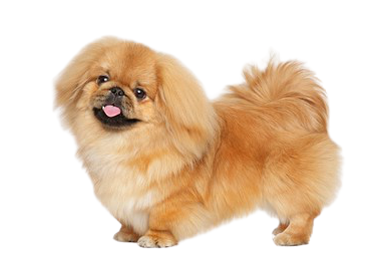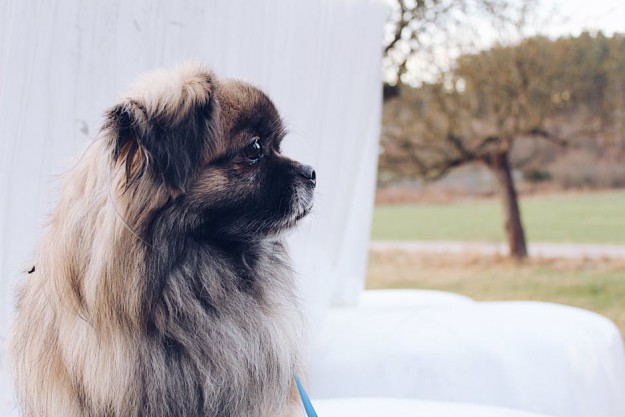
Pekingese
USD $600-$800 Price Avg.
Companion Dogs
Group
Purebred
Breed Type
Small
Size
13-15 years
Lifespan
Breed Information
| Group | Companion Dogs |
|---|---|
| Popularity/Rank | 88 |
| Origin | China |
| Other Names | Chinese Spaniel, Lion Dog, Peke, Peking Lion Dog, Peking Palasthund, Pelchie Dog |
| Breed Type | Purebred |
| Price (Avg.) |
USD $600-$800
How much does a Pekingese cost? According to a rough estimate, you will spend between $600 to $800 on your Pekingese if you purchase it from a reputable breeder. If you select a dog with exceptional bloodlines, the price may be higher. The price might even be higher if the dog has already been trained. You'll usually pay less if you get a Pekingese from a shelter. |
| Size | Small |
| Weight | 8-10 pounds (3.6-4.5 kg) |
| Height | 6-9 inches (30.4-45 cm) |
| Lifespan | 13-15 years |
| Recognized by |
AKC, FCI
The American Kennel Club in 1906 as a Toy breed. And FCI in the Companion and Toy Dogs group, in the Japan Chin and Pekingese section. |
| Purpose | Lap dog |
| Date of Origin | 8th Century |
| Ancestry | Unknown |
Appearance & Maintenance
| Coat | Dense |
|---|---|
| Coat Colors | Black, Cream, Fawn, Gray, Red, White |
| Grooming Level | |
| Shedding Level | |
| Eye Color Possibilities | Brown |
| Nose Color Possibilities | Black |
| Coat Color Possibilities | Black, Brindle, Cream, Fawn, Gray |
| Coat Length | Large |
| Coat Density | Dense |
| Coat Texture | Straight |
| Recommended Brushes | Comb, Nail Clipper, Scissors, Slicker Brush |
| Brushing Frequency | Weekly |
Breed Characteristics
| Temperament | Affectionate, Aggressive, Caring, Good-natured, Intelligent, Opinionated, Stubborn |
|---|---|
| Intelligent | |
| Trainability | |
| Playfulness | |
| Sensitivity Level | |
| Affection Level | |
| Social Interaction Required | |
| Barking | |
| Watchdog Ability | |
| Territorial | |
| Biting Force | Low |
| Mouthiness | |
| Impulse to Wander or Roam | |
| Prey Drive | |
| Adaptability | |
| Tolerates Being Left Alone | |
| Fighting Dog | Not really |
Good & Friendly with
| Apartment Life Friendly | |
|---|---|
| Stranger Friendly | |
| Kid-Friendly | |
| Cat Friendly | |
| Dog Friendly | |
| Office Friendly | No |
| Senior Citizens Friendly | |
| Pet Friendly | |
| Friendly with First Time Owners | Yes |
| Service Dog | Not really |
| Therapy Dog | Not really |
| Detection, Sniffer or Security Dog | Not really |
| Search and Rescue Dog (SAR) | Not really |
| Boat Dog | Not really |
| Cart Pulling or Drafting Dog | Not really |
Health Elements
| Health Issues | |
|---|---|
| Health Problems | Brachycephalic Syndrome, Cataracts, Cleft Palate, Cryptorchidism, Distichiasis, Ectopic Cilia, Entropion, Exposure Keratopathy Syndrome, Hydrocephalus, Intervertebral Disk Disease, Keratoconj |
| Hypoallergenic | No |
| Energy Level | |
| Exercise Required | |
| Sleeping Required | |
| Weight Gain Potential | |
| Weather & Climate | Prefers average to cold weather conditions |
| Stinkiness | High |
| Drooling tendency | |
| Activity Level | Low |
| Rec. Walk Mileage Per Week | 6 miles |
| Minutes of Activity Per Day | 20 minutes |
Food & Costing
| Avg. Daily Food | 1/4 to 1/2 cup of high-quality dry food a day, divided into two meals. |
|---|---|
| Cups Per Day | 1 cups |
| Daily Cost | $0.75 - $1.00 |
| Monthly Cost | $25.00 - $30.00 |
Reproducibility
| Gestation Duration | 60-64 days |
|---|---|
| How often can the Pekingese have a litter? | Once a year. |
| Litter Size | 2-4 puppies (Once a year.) |
Description
The Pekingese is a small, sturdy dog breed that originated in China. They are known for their long, flowing coats and their distinctive lion-like appearance. The Pekingese has a lifespan of 12 to 15 years and can weigh anywhere from 6 to 14 pounds. They come in a variety of colors including black, white, cream, red, sable, and brindle.
The Pekingese is an intelligent and loyal breed that loves to be around its family. They are very affectionate and enjoy being the center of attention. They can be independent at times but they also love to cuddle up with their owners. The Pekingese is also known for its courage and loyalty which makes them great watchdogs as well as companions.
The Pekingese is generally friendly with other dogs but may be wary of strangers or unfamiliar animals. With proper socialization they can get along well with children as well as other pets in the household such as cats or birds.
The temperament of the Pekingese is usually calm but alert when necessary. They are not overly active dogs so they do not require much exercise but they do need regular walks or playtime to stay healthy and happy.
When it comes to health issues the Pekingese may suffer from eye problems such as cataracts or glaucoma due to their protruding eyes; breathing problems due to their short noses; skin allergies; joint problems; heart disease; obesity; dental issues; ear infections; hypothyroidism; luxating patellas (dislocated kneecaps); hip dysplasia; and seizures among others so it’s important for owners to keep an eye out for any signs of illness or discomfort in their pet’s behavior or physical appearance so that treatment can be sought out if needed.
The adaptability level of the Pekingese is moderate meaning that while they do not require too much exercise they still need some activity each day such as walks or playtime in order to stay healthy both physically and mentally so it’s important for owners who live in apartments or have limited space available for exercise activities should consider this before getting a pet like this one since it will need some form of daily activity even if it’s just playing indoors with toys every now and then .
Overall the benefits of having a pet like this one include having an intelligent companion who loves being around its family members all day long while providing protection when needed thanks to its courageous nature making them great watchdogs too! Plus since these dogs don’t require too much exercise you won’t have worry about taking them on long walks every day either which makes them ideal pets for those who don’t have enough time on their hands!
History
The Pekingese is an ancient breed of toy dog, originating in China. The breed is named after the city of Beijing, where it was first developed. Pekingese were originally bred as companions for Chinese royalty, and were prized for their small size and lion-like appearance. In the 19th century, British soldiers stationed in China brought several Pekingese back to England, where they quickly became popular among the upper class. The breed soon spread to other parts of Europe and North America.
Pekingese nearly became extinct in the early 20th century, due to a combination of political turmoil in China and World War I. However, a few dedicated breeders kept the breed alive, and it eventually regained its popularity. Today, Pekingese are still prized as companion dogs and are recognized by most major kennel clubs.
The ancestry of the Pekingese is somewhat mysterious, as there are no records of the breed prior to the 19th century. However, it is believed that the Pekingese is descended from a number of other small Asian breeds, including the Shih Tzu and Pug. The exact origins of the Pekingese are unknown, but the breed is thought to be at least 1,000 years old.
The Pekingese was first recognized as a distinct breed in England in 1894. The first American Kennel Club standard for the breed was approved in 1906. Today, Pekingese are one of the most popular toy breeds in both Europe and North America.








